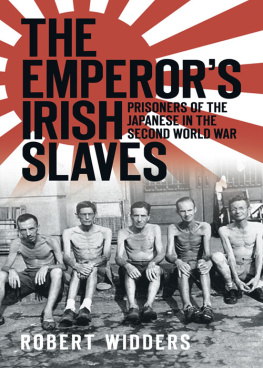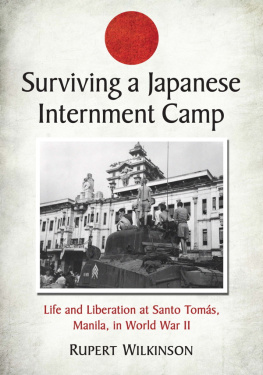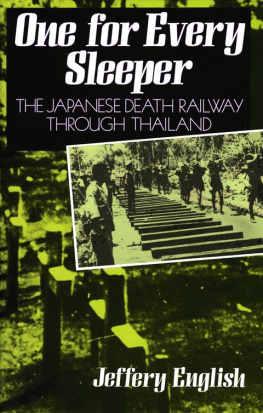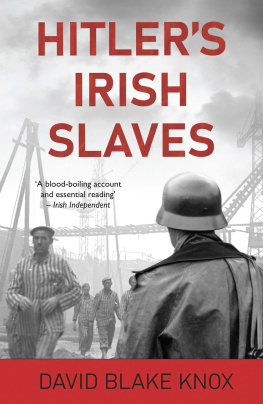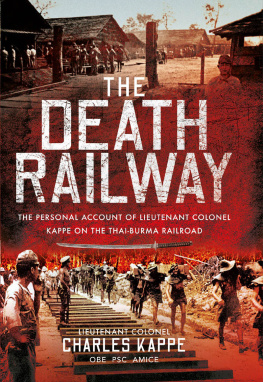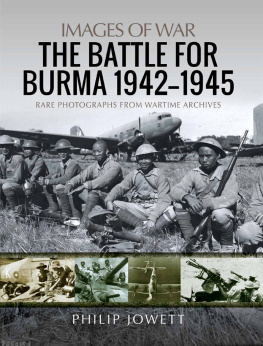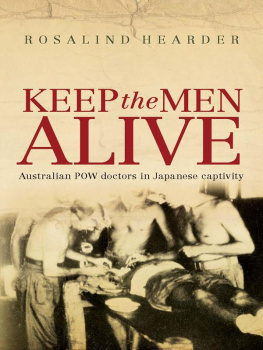In caram matris meae memoriam
Sylvia May Widders
19301987
Dedicated to:
My niece, Jennifer Carmichael, and her beautiful daughter, Isabelle Rose.
My niece, Danielle Tara Peet, and my great-nephews, Oliver and Harry Peet.
CONTENTS
Many people have generously helped me during my research and I am extremely grateful to each and every one.
Harold Lock and George Simmonds are two of the dwindling band of Far East Prisoners of War Im indebted to them both for opening up old wounds and recounting their experiences to me. My friend, W.T.G. Gordon Smale, another FEPOW, shared his experiences with me on many occasions and Sergeant Major Eric Burgoyne kindly allowed me to use material from his memoir of the British Sumatra Battalion.
Other FEPOWs, in the past, and recently, provided information for this book but chose not to be acknowledged by name, or are no longer here to be asked. Many FEPOWs preferred that their families should not know too much about their experiences. The comment, from POWs children, or grandchildren, that, he only ever spoke about it in the year or so before he died is a common one. I am most grateful to the men who spoke to me.
Thank you to the staff of the Thailand Burma Railway Centre (TBRC): Rod Beattie walked along the Death Railway with me; Andrew Snow patiently clarified various pieces of information and found references; Cliff Clegg guided me to Fusilier Kenneallys execution site. Their help has been invaluable.
The TBRC provides help and advice to anyone wishing to research a family member who worked on the Burma Railway. The museum, at Kanchanaburi, next to the Commonwealth War Graves Commission cemetery, provides a moving testament to the POWs: www.tbrconline.com.
Thank you to Tony Banham for help with issues relating to the Hong Kong POWs. His excellent book, The Sinking of the Lisbon Maru, gives a comprehensive account of the sinking. Anyone researching POWs captured in Hong Kong should consult Tonys website: www.hongkongwardiary.com.
Im grateful to the Java FEPOW Club 1942 for permission to quote from Prisoners in Java. The club is the UKs last remaining national FEPOW veterans association:
Our goals are to support the remaining veterans with welfare advice and camaraderie, as well as helping researchers find out more about the FEPOW experience, so that it may be remembered, and their sacrifices honoured, for generations to come.
Associate membership is open to POWs families and friends, and to anyone who supports the clubs objectives: www.thejavafepowclub42.org.
The following people (in no particular order) generously helped me: Rod Suddaby, Margaret Martin, Lesley Clark, Jim McCorry, Kieran Coughlan, Paul Norris, Bernie McGee, Paul Cullen, Maurice OConnell, Jonathan Moffatt, Meg Parkes, Alan Matthews, Richard Wall, Lois Mayne, Joanna Farrell, Denis Drinan, Professor G.R. Batho and Christopher Munn. If Ive forgotten anyone, I apologise.
My thanks also goes to Nic, Henry, and the girls at Chickpea Cafe, Cotham Brow, Bristol, where I sat and wrote much of this book; thank you for the many excellent meals and the copious quantities of tea.
Sister Mary Cooper, from Carrickmacross, died in a Japanese prison camp on 26 June 1943, from the combined effects of starvation, brutality, and tropical diseases. Two Irishmen, Timothy Kenneally and Patrick Fitzgerald, tried to escape from a slave labour camp on the Burma Railway and were caught, tortured, possibly crucified, and then executed on 27 March 1943. Dozens of Irish soldiers were deliberately locked in the hold of the Lisbon Maru when it sank on 2 October 1942: those men who managed to break out were machine-gunned in the water. Patrick Carberry, from Dublin, spent the summer of 1943 cremating the emaciated corpses of his comrades who had died from cholera. And William Perrott, from Askeaton, County Limerick, was one of a group of Irishmen who were beaten, starved, and then forced to dig their own graves before being massacred on a tropical island.
These people had two things in common: they were Irish citizens serving with the British armed forces; and they were amongst more than 650 Irish men and women who became prisoners of the Imperial Japanese Army in 1942. They suffered an incarceration marked by starvation, disease, and the denial of medical treatment. Beatings were routine, torture was commonplace, and illegal execution far from rare.
In Europe during the Second World War around 4 per cent of the Irish Prisoners of War (POW) held by Germany died in captivity. Yet by the time the Japanese POW camps were liberated in 1945, 23 per cent of the Irish POWs were dead. The remainder with few exceptions were physically ill and psychologically traumatised.
Of course, as one Irish veteran made clear, in a letter written after the war to his sister in Ireland, Far East POWs (FEPOW) shared a commonality of experience regardless of nationality. Patrick Harrington, a big man, weighing thirteen stone before the war, was a seven-stone walking skeleton when he was liberated in 1945. As he told his sister, this was a result of a diet of a cup of flour boiled in water for breakfast, and two cups of watery rice, with whatever grass or weeds the cooks could find, in the evening. The desperation showed plainly in Patricks anecdote; I once got the makings for seven fags from a doctor for a dead rat. He skinned and cooked an ate it as if it was a pork chop.
Like many POWs, Patrick returned home with ulcers on his legs. We can only imagine his sisters thoughts when she heard of Patricks fellow POWs having leg amputations without anaesthesia, because of ulcers. It must have broken this Irish girls heart imagining her brother slaving on the Burma Railway, without boots, almost naked, starving, and being flogged when he collapsed with fatigue. But, as Harrington pointed out, this:
was the experience of every man who was there. I do not want you to get the impression that I was any worse than anyone else, I wasnt. If you talk to any soldier who was in this Singapore show he will tell you the same story I am telling you.
But this book doesnt tell the story of all the POWs, the men and women of many nationalities, who suffered in Japanese captivity. Neither is it a comprehensive account of every aspect of a POWs daily existence. This book has one simple aim: to give voice to the 650 Irish citizens who served with the British armed forces and became POWs of the Japanese.
After the war, the surviving POWs came home to societies that felt they had experienced enough themselves: rationing, austerity, bereavements, and the rest of the miseries that blighted the civilian population through the war years. Few people then, aside from those who experienced it, knew just how awful Japanese captivity had been. So public sympathy was necessarily limited. People wanted to move on, forget the war, and look to the future and the FEPOWs were just one more group of sufferers in an era when victims were in plentiful supply. So they did their best to get on with life, keeping the lingering effects of tropical diseases and the ticking time bomb of Post Traumatic Stress Disorder hidden behind the stiff upper lip expected of their generation. And in Southern Ireland the POWs faced the added problem of returning to a society ambivalent and sometimes hostile towards those who had travelled abroad to serve with the British Army.
Of course, not all surviving Irish FEPOWs returned to live in Ireland; some chose to live in the UK. But those who returned faced opprobrium. For the former POWs, the need for silence for security reasons was just one more added burden. Yet these are the men who fought for us in the most dreadful war in modern history. They helped defeat the three-way alliance of Nazi Germany, Fascist Italy, and militarist Japan that held the world in an iron grip of evil. It is
Next page
